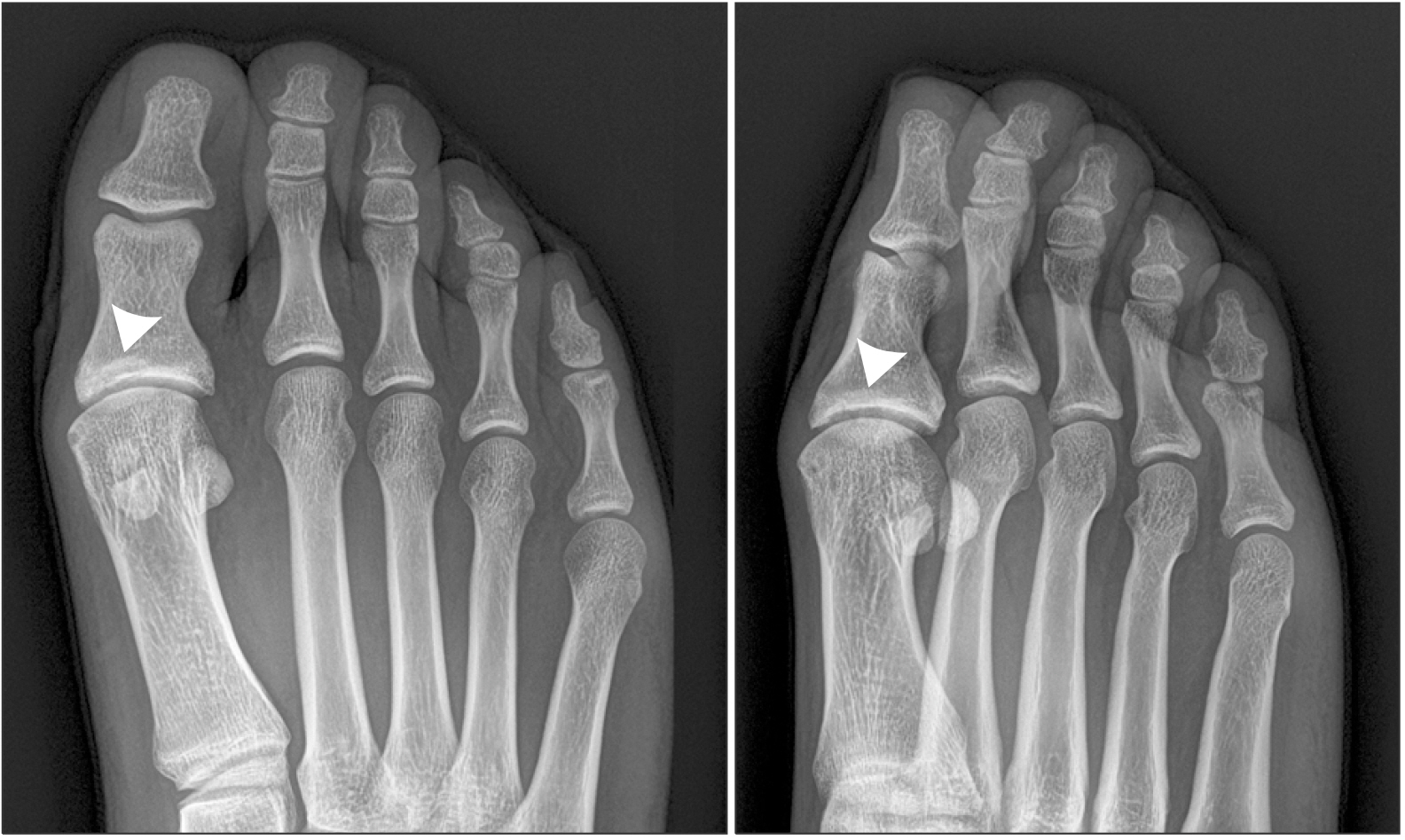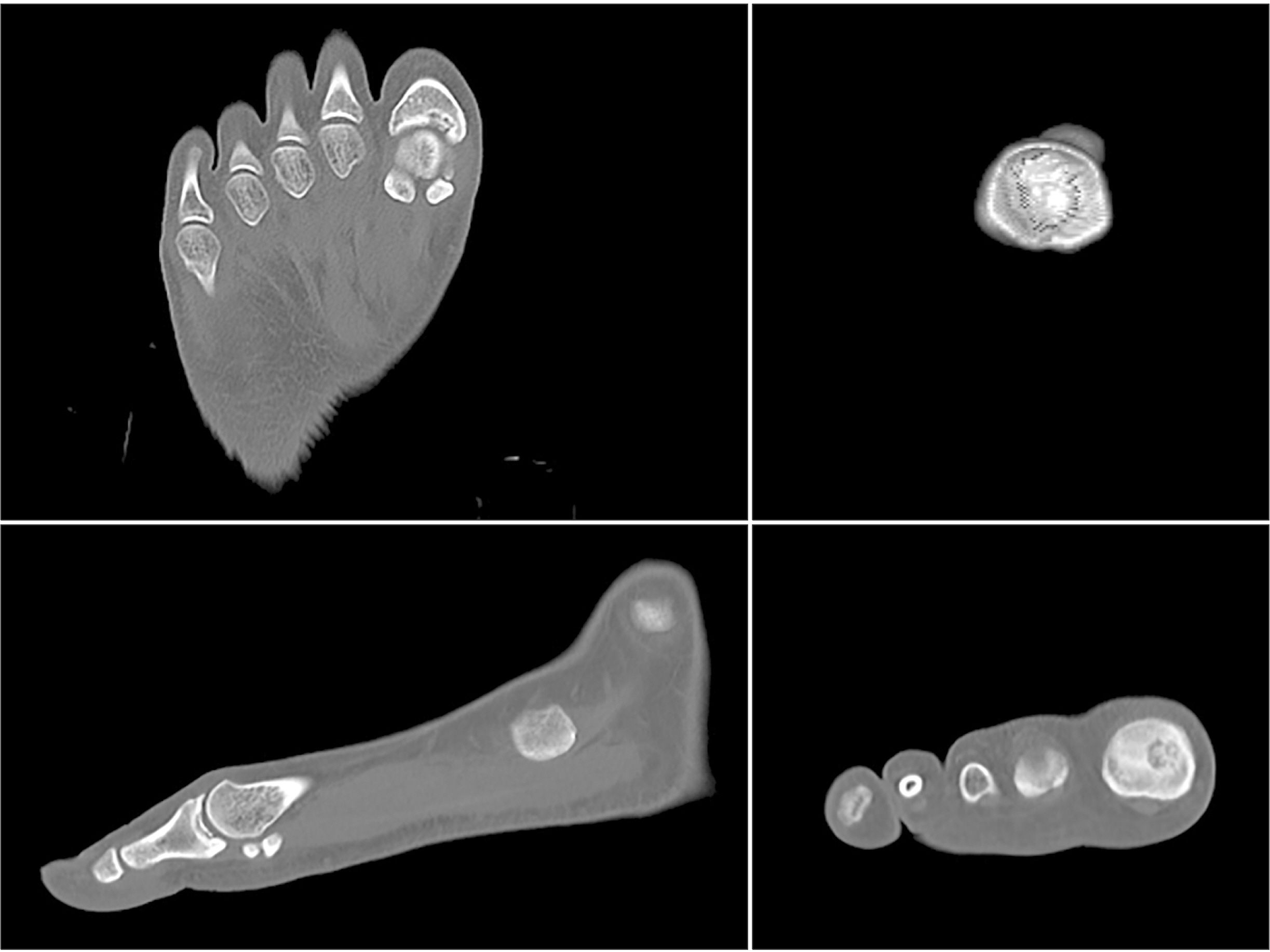Korean J Sports Med.
2022 Jun;40(2):138-141. 10.5763/kjsm.2022.40.2.138.
Osteochondral Lesion at the Proximal Phalangeal Base of the Hallux: A Case Report
- Affiliations
-
- 1Departments of Orthopedic Surgery, Armed Forces Yangju Hospital, Yangju, Korea
- 2Departments of Rehabilitation Medicine, Armed Forces Yangju Hospital, Yangju, Korea
- KMID: 2530317
- DOI: http://doi.org/10.5763/kjsm.2022.40.2.138
Abstract
- Although osteochondral lesions are well-described in previous literature, lesions located at the proximal phalangeal base of the hallux are extremely rare. Here, the authors report the case of a 21-year-old male who presented with chronic right great toe pain, which was eventually diagnosed as an osteochondral lesion at the proximal phalangeal base of the hallux. The diagnosis presented herein should be kept in mind and included in the differential diagnosis when patients complain of chronic pain in the great toe.
Keyword
Figure
Reference
-
1. Cahill BR. 1997; Current concepts review: osteochondritis dissecans. J Bone Joint Surg Am. 79:471–2. DOI: 10.2106/00004623-199703000-00027. PMID: 9070543.2. Altman A, Nery C, Sanhudo A, Pinzur MS. 2008; Osteochondral injury of the hallux in beach soccer players. Foot Ankle Int. 29:919–21. DOI: 10.3113/FAI.2008.0919. PMID: 18778671.
Article3. Delniotis I, Leidinger B. 2020; A case report of osteochondritis dissecans of the first metatarsophalangeal joint treated with autologous cancellous bone and chondral flap reconstruction. J Surg Case Rep. 2020:rjaa026. DOI: 10.1093/jscr/rjaa026. PMID: 32153761. PMCID: PMC7054208.
Article4. Figueiredo SA, Machado LM, Rodrigues JF, Sa AE. 2015; Osteochondral lesions at the interphalangeal joint of the hallux. JBJS Case Connect. 5:e89. DOI: 10.2106/JBJS.CC.N.00256. PMID: 29252795.
Article5. Kinoshita M, Okuda R, Morikawa J, Yasuda T, Jotoku T, Abe M. 1998; Osteochondral lesions of the proximal phalanx of the great toe: a report of two cases. Foot Ankle Int. 19:252–4. DOI: 10.1177/107110079801900413. PMID: 9578107.
Article6. Bruno MA, Marcos RF, Wagner FV, Wagner FV. 2021; Treatment of osteochondral lesion of the first metatarsal head: osteochondral graft transplantation combined with Moberg osteotomy: case report. Foot Ankle Spec. 14:515–20. DOI: 10.1177/19386400211001972. PMID: 33853417.
Article7. Sherman TI, Kern M, Marcel J, Butler A, McGuigan FX. 2016; First metatarsophalangeal joint arthroscopy for osteochondral lesions. Arthrosc Tech. 5:e513–8. DOI: 10.1016/j.eats.2016.02.011. PMID: 27656371. PMCID: PMC5021517.
Article8. Clanton TO, Butler JE, Eggert A. 1986; Injuries to the metatarsophalangeal joints in athletes. Foot Ankle. 7:162–76. DOI: 10.1177/107110078600700306. PMID: 3804139.
Article9. Maciejewski R, Callanta H. 2016; Injuries and training variables in Filipino judo athletes. Biomed Hum Kinet. 8:165–72. DOI: 10.1515/bhk-2016-0024.
Article10. Pocecco E, Ruedl G, Stankovic N, et al. 2013; Injuries in judo: a systematic literature review including suggestions for prevention. Br J Sports Med. 47:1139–43. DOI: 10.1136/bjsports-2013-092886. PMID: 24255909.
Article11. Kim KS, Park KJ, Lee J, Kang BY. 2015; Injuries in national Olympic level judo athletes: an epidemiological study. Br J Sports Med. 49:1144–50. DOI: 10.1136/bjsports-2014-094365. PMID: 26216871.
Article12. Boissonnault WG, Donatelli RA. 1984; The influence of hallux extension on the foot during ambulation. J Orthop Sports Phys Ther. 5:240–2. DOI: 10.2519/jospt.1984.5.5.240. PMID: 18806402.
Article13. Pascual-Garrido C, McNickle AG, Cole BJ. 2009; Surgical treatment options for osteochondritis dissecans of the knee. Sports Health. 1:326–34. DOI: 10.1177/1941738109334216. PMID: 23015890. PMCID: PMC3445128.
Article
- Full Text Links
- Actions
-
Cited
- CITED
-
- Close
- Share
- Similar articles
-
- Surgical Treatment of Pediatric Intra-Articular Proximal Phalangeal Head Fracture of the Big Toe
- Osteochondral Autograft Using Head of Proximal Phalanx of Toe for Partial Osteochondral Defect of Proximal Interphalangeal Joint: A Case Report
- Simultaneously Occurred Medial and Lateral Osteochondral Lesions of the Talus
- Osteochondral Lesion of the Tibial Plafond: A Case Report
- Operative Treatment of Hallux Valgus




